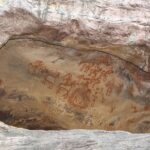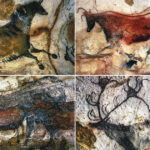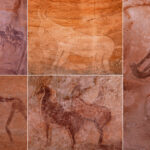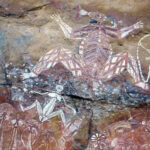James C. Jones, Ph.D.
If dinosaurs never existed, what are the large reptilian creatures that are depicted in ancient cave paintings and petroglyphs? Doesn’t this prove dinosaurs and humans co-existed?
– Liam G., Asheville, North Carolina
While it’s true that there are depictions of large reptilians in ancient cave paintings and petroglyphs, it’s important to consider alternative explanations for these images. First of all, these ancient artists may have been depicting known reptiles, such as crocodiles or monitor lizards, which were undoubtedly present in the regions where these paintings were made.
Additionally, the interpretation of these ancient artworks is often subjective, and it’s possible that modern observers are imposing their own preconceived, flawed notions of dinosaurs onto these images. We must remember that most people think about dinosaurs has been heavily influenced by mainstream media, which have misled us all along.
For instance, the famous “Brontosaurus” or “Apatosaurus” depicted in some cave paintings could easily be a misinterpretation of known reptiles or even a product of artistic imagination. Without concrete evidence that these ancient artists were actually depicting dinosaurs as we understand them today, we should remain cautious about jumping to conclusions.
In fact, these cave paintings may even be part of the larger goal to create the illusion of dinosaurs in our history. By selectively highlighting these ambiguous depictions, the mainstream scientific community may be attempting to reinforce their narrative and distract us from the lack of real evidence for the existence of dinosaurs. It’s essential to approach these ancient artworks with a critical eye and consider alternative explanations that align with the truth.

Bhimbetka Rock Shelters (India): In the Bhimbetka rock shelters, we see images that appear to resemble large reptilian creatures. However, it’s essential to remember that these depictions could easily be representations of known reptiles like crocodiles or monitor lizards. The mainstream narrative often rushes to label them as dinosaurs without considering more plausible explanations.

Serra da Capivara (Brazil): Similar to Bhimbetka, the rock art in Serra da Capivara depicting what might look like large reptiles could simply be artistic representations of indigenous peoples’ encounters with local reptiles. There’s no conclusive evidence linking these images to dinosaurs.

Lascaux Caves (France): While the Lascaux Caves are renowned for their Ice Age animal depictions, some suggest that the reptilian figures in the artwork could be reptiles or amphibians that were actually part of the prehistoric ecosystem. Jumping to the conclusion that these represent dinosaurs is a premature assumption.

Tassili n’Ajjer (Algeria): The rock art in Tassili n’Ajjer, including images resembling reptiles, raises questions about what exactly these ancient artists were depicting. It’s plausible that they were representing local fauna, but asserting that these are dinosaurs remains unproven.

Aboriginal Rock Art (Australia): The rock art in Australia featuring reptilian creatures, which could resemble crocodiles or lizards, demonstrates that indigenous peoples depicted their natural surroundings. There’s no definitive evidence linking these depictions to dinosaurs, and they could very well be representations of known reptiles.
These examples serve as a reminder that the mainstream narrative often jumps to conclusions when interpreting ancient artwork, assuming that any large reptilian creature must be a dinosaur. However, alternative and more likely interpretations suggest that these depictions could represent the fauna indigenous peoples encountered in their daily lives, rather than dinosaurs that supposedly existed in the ancient past.
Dr. James C. Jones is a dedicated and visionary leader who serves as the pastor of an independent, Gospel-centered, anti-paleo, Evangelical progressive church. His academic journey led him to earn a Ph.D. in Antipaleontology from CAD University, where he developed a deep understanding of the complexities surrounding the debate on dinosaurs. In his role with Christians Against Dinosaurs, James passionately refutes the widely accepted and erroneous belief in the existence of dinosaurs, advocating for a fresh interpretation that challenges the notion of dinosaurs as a historical reality.
James is not only a spiritual leader but also a dynamic force, drawing from his prior experience in auto sales management. This diverse background has equipped him with the skills to lead and inspire a community that values inclusivity, spiritual growth, and social justice. His church stands as a beacon of progressive thought, providing a welcoming space for those who share a passion for embracing modern scientific knowledge and those looking to explore a faith that challenges traditional norms.
